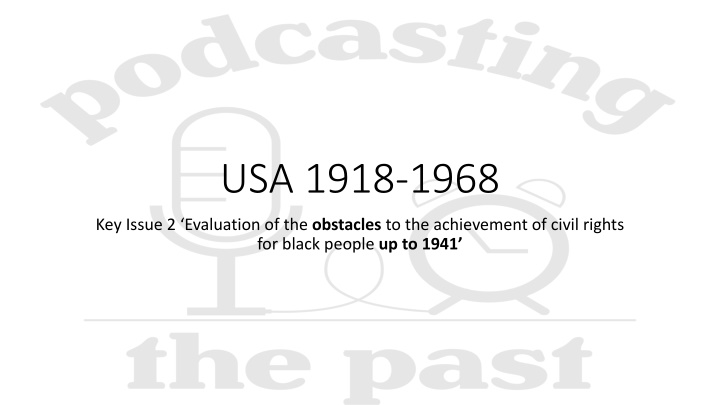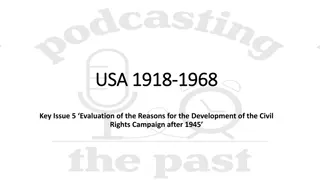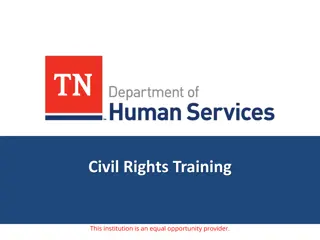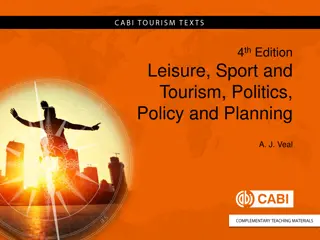Evaluation of Civil Rights Obstacles for Black People in USA Up to 1941
The obstacles to achieving civil rights for black people in the USA up to 1941 were significant, including factors like the KKK's resurgence in the 1920s, divisions in the black community, legal impediments, lack of political influence, and popular prejudice. The KKK's influence over law and law makers, use of fear and violence to promote white supremacy, and widespread support posed major barriers to civil rights progress, with lynching and violence creating a climate of fear. Despite constitutional amendments granting citizenship and voting rights, systemic obstacles persisted, hindering the advancement of civil rights for black Americans.
Download Presentation

Please find below an Image/Link to download the presentation.
The content on the website is provided AS IS for your information and personal use only. It may not be sold, licensed, or shared on other websites without obtaining consent from the author.If you encounter any issues during the download, it is possible that the publisher has removed the file from their server.
You are allowed to download the files provided on this website for personal or commercial use, subject to the condition that they are used lawfully. All files are the property of their respective owners.
The content on the website is provided AS IS for your information and personal use only. It may not be sold, licensed, or shared on other websites without obtaining consent from the author.
E N D
Presentation Transcript
USA 1918-1968 Key Issue 2 Evaluation of the obstacles to the achievement of civil rights for black people up to 1941
Factors / Obstacles KKK Divisions in Black community Legal impediments Lack of political influence Popular prejudice
Context Following the end of the Civil War in 1865 and the defeat of the South, slavery was abolished across America The 13thand 14thamendments to the Constitution outlawed slavery and made all Blacks American citizens The 15thamendment gave Black males the right to vote
KKK Knowledge (K1) Originally formed in 1860s with the direct purpose of preventing former slaves enjoying equal rights (K1) They experienced a resurgence in 1920s, in order to protect the American way of life . (K1) By 1924-25, their membership was around 3 million (K1) This was the first time their membership extended beyond Southern States (K1) 100% Americanism (K1) Members must be male WASPs over 16 (K1) They used fear, intimidation and violence to promote white supremacy (K1) Following concerns over immigration, their message resonated with many Americans
KKK Knowledge (K2) In 1925, 40,000 Klansmen marched openly through Washington DC (K2) Hiram Wesley Evans - leader in 1923. (K2) The Invisible Empire (K2) Judges, lawyers, teachers, policemen, doctors and politicians anyone could be a hidden KKK member (K2) They wielded influence over the law and law makers (K3) Tactics of lynching, torture and violence were characteristic of this secret organisation. (K3) 416 Black Americans were killed in lynchings between 1918-27 (K3) White Americans who campaigned in support of Black Americans were also targeted
KKK Analysis (A1) The Klan's widespread support and popularity made it a significant barrier to the progress of civil rights, especially segregation (A1) Their support in the North and South made this even more significant (A2) President Roosevelt refused to support an anti-lynching bill in his New Deal for fear of losing political support in south, therefore allowing lynching to continue unpunished. (A2) In some states, only KKK approved candidates could stand for election proving their political power. (A2) The membership of powerful individuals meant few Klansmen were ever held to account for their crimes (A3) Lynching resulted in a black population too terrified to campaign for fear of the consequences. (A3) Many White Americans were also persecuted for trying to help
KKK- Analysis Plus (A+1) By 1920s, scandals discredited the KKK. In Alabama, where they had been most powerful, they numbered less than 6,000 by 1930 but they remained powerful in local groups. (A+1) Laws against wearing masks in public and membership fees which were too expensive during the depression also led to a decline in membership and influence. (A+1) Therefore -> other obstacles must have existed
KKK- Evaluation (EV 1) David M. Chalmers: the Klan relied on local anarchic autonomy basically, that they could do what they wanted because no one could force the Southern states to behave differently. (EV 1) Frederick Lewis Allen: Klan resurgence after WWI due to growing social and economic inequalities a movement conceived in fear and perpetuated fear and brought with it all manner of cruelties and crimes (EV 1) Paul S. Boyer: The Klan s promise to restore the nation to an imagined purity ethical, moral and religious appealed powerfully to ill-educated and deeply religious Americans
Divisions within the Black Community- Background Early civil rights campaigns emerged after 1896 as a reaction to the Plessy vs Ferguson case Several organisations were formed to help improve the lives of Black Americans There were three main leaders who had 3 very different ideas about how to get Civil Rights for Black Americans: Booker T Washington, W.E.B. Du Bois and Marcus Garvey
Divisions within the Black Community- Knowledge (K1) Booker T Washington. He was born in 1856 as the son of a slave (K1) He established the Tuskagee Institute in Alabama which gave Black children an education with a focus on practical skills in farming, carpentry, brick making etc. (K1) He wanted to improve education for black people believing this was the best way to create better opportunities (K1) The great success of the school made him believe that Black people could ONLY advance if they were educated (K1) He argued that black Americans should not antagonise whites by demanding political and social equality but should earn respect through hard work and education (accommodationist philosophy) (K1) He was regarded as an Uncle Tom by many a derogatory term to mean an exceedingly subservient person
Divisions within the Black Community- Knowledge (K2) W.E.B. Du Bois (K2) The first Black American ever to receive a degree from Harvard University (K2) He began the first Civil Rights Movement 1909 the N.A.A.C.P (the National Association for the Advancement of Coloured People) (K2) He demanded full civil rights, the end of segregation and equality of opportunity in all aspects of life and work (K2) The NAACP included white campaigners (K2) The NAACP used legal action in its fight to improve employment, housing, voting and education (K2) He argued that Washington s stance simply encouraged White people to maintain the status quo (K2) In 1919 he campaigned against lynching, but it failed to attract many black people and was dominated by white people and well-off black people
Divisions within the Black Community- Knowledge (K3) Marcus Garvey believed in Negro Nationalism which encouraged black culture and pride in being black (K3) 1916 he introduced the first Universal Negro Improvement Association (UNIA) to New York City which aimed to get blacks to take Africa, organise it, develop it, arm it, and make it the defender of Negroes the world over . (K3) He argued racial bias was ingrained in whites that it was impossible for them to change their views & saw all whites as potential Klansmen (K3) He urged blacks to liberate themselves from surrounding white culture and embrace their own heritage (K3) He proposed that all Black Americans should return to Africa and start their own self-governing republic there (K3) In 1922 there were 6 million members. He was convicted of fraud and eventually deported from the USA
Divisions within the Black Community- Analysis (A1) He was criticised for this by Black leaders but in the long term his belief in education would help improve the lives of many Black Americans (A2) Although it had 91,000 members in 1919 it failed to win over the mass of ordinary black people & so little progress was made (A3) Although he achieved little that was tangible in the short term, Garvey helped to foster a sense of Black pride which would inspire later generations to take up the charge of civil rights campaigning.
Divisions within the Black Community- Analysis Plus (A+1&2) These differences resulted in a weakened campaign before 1941, due to a lack of cohesion. (A+1&2) -The disagreements in approach and ideology led to shared goals but not a shared approach and therefore had little impact on the establishment.
Legal Impediments Knowledge (K1) Following the Civil War, Jim Crow Laws were passed in Southern States (K1) These were a series of restrictive laws targeting Black people and forcing them into segregation and keeping them under control (K1) They enforced: separate education, transport, toilets, restaurants, cinemas and many other aspects of everyday life (K2) Homer Plessey took Separate but Equal to the Supreme Court Decision in 1896 but it WAS deemed constitutional and allowed to stand (K3) Attitudes of people in power, for example President Woodrow Wilson, provided legal impediments to black people (K3) Segregation is not humiliating and is a benefit for you black gentlemen . Wilson also called them an ignorant and inferior race
Legal Impediments Analysis (A1) This gave legal justification to racism as long as facilities were separate but equal with whites. (A1) It restricted their civil rights and resulted in apathetic black Americans. (A1) Many facilities were not equal and segregation was now engrained in all walks of life (A2) This proved a significant legal obstacle as the Supreme Court was the ultimate legal authority in the USA (A3) An unsympathetic president and government would prevent further reforms being passed that would improve civil rights for blacks
Legal Impediments Analysis Plus (A+) The Jim Crow Laws which prevented black Americans from living a normal life did not exist in the northern states (A+) This allowed blacks to be more accepted in society and they were not prevented from voting by the laws of the South. (A+) It also provided stimulus to the formation of the NAACP and would form the basis of the land mark case: Brown vs Board of Education
Lack of Political Influence - Knowledge (K1) In 1900, 180,000 Blacks could vote in Alabama (K1) In 1902, only 3,000 could vote, this was despite a constitutional right to vote (K1) Therefore they could not elect someone willing to fight for civil rights. Voting registration rules were an important obstacle. (K2) State law was challenged in 1898 with the case of Mississippi v Williams it was argued that the voting requirements in Mississippi discriminated against Blacks, breaking Federal Law (K2) Mississippi demanded voters must understand the American Constitution, pay Poll Tax and pass literacy tests. (K2) Many Blacks could not meet these demands but because ALL voters had to pass these requirements, the case was dismissed
Lack of Political Influence - Knowledge (K3) Another impediment was the Grandfather Clause blacks were only eligible to vote if their grandfather was eligible (K3) Finally, most black people in the South were sharecroppers and did not own land. (K3) Some states identified ownership of property as a voting qualification.
Lack of Political Influence Analysis (A1) Therefore black people could not vote and could not elect anyone who would oppose the Jim Crow Laws (A1) This was a direct obstacle to the achievement of civil rights. (A2) Little was achieved to end discrimination and black political activists were a minority. (A2) Blacks lacked political education and experience to change these racist policies.
Lack of Political Influence Analysis Plus (A+) However, Blacks in the North did not face Jim Crow, could vote and fully participate in civil affairs (A+) With the migration of many Blacks to Northern states for work, their votes proved more important for politicians, prompting action (A+) By 1939, some Southern states had removed the poll tax, allowing many Blacks to vote (A+) Therefore, change was happening in the South
Popular Prejudice Knowledge (K1) As a result of the institution of slavery, the status of Africans was stigmatised. This stigma was the basis for the anti-African racism that persisted (K2) Millions of African Americans migrated from their roots in the Southern states to the industrial centres of the North after World War I, particularly in cities such as Boston, Chicago, and New York (Harlem). (K2) Black migrants were seen as a threat to white job security and worsening housing shortages (K2) In northern cities, racial tensions exploded, most violently in Chicago, and lynching (racially motivated, mob hangings) increased dramatically in the 1920s.
Popular Prejudice Analysis (A1) Civil Rights was treated with hostility and as a target for hatred. (A1) Poor, white Americans targeted Blacks as the source of their own economic and social problems (A2) Most African Americans were more concerned with their economic survival than any change to their political standing.
Popular Prejudice Analysis Plus (A+1) With the spread of Jazz across America, a largely Black cultural theme, it appeared that Blacks were becoming more accepted across America (A+2) Many of the tensions experienced in the north were economic in origin and not based on race























